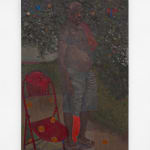Miguel Afa
Sem título [Untitled], 2024
óleo sobre tela
[oil on canvas]
[oil on canvas]
156 x 95 x 3.5 cm
[61 3/8 x 37 3/8 x 1 3/8 in]
[61 3/8 x 37 3/8 x 1 3/8 in]
Copyright The Artist
Further images
Nesta pintura, Miguel Afa consagra a figura arquetípica do malandro suburbano -personagem popular, encantado e encantador- como uma entidade do território urbano carioca. Em pé, de chinelos, com camisa lançada...
Nesta pintura, Miguel Afa consagra a figura arquetípica do malandro suburbano -personagem popular, encantado e encantador- como uma entidade do território urbano carioca. Em pé, de chinelos, com camisa lançada sobre os ombros e uma presença que beira uma alegoria mítica, "esse corpo maduro carrega não só os sinais da experiência, mas a firmeza de quem conhece o valor da palavra e do gesto", afirma o artista. Seu entorno, com destaque para a cadeira vermelha que, na pintura, funciona como extensão simbólica da mesa de bar, afirma a importância de seus espaços: a esquina, o quintal e o botequim.
A composição é marcada pela construção de um altar profano, onde o cotidiano e o sagrado se entrelaçam. A cadeira não é apenas lugar de descanso, mas trono. A cerveja que ali se imagina, ainda que ausente da cena, é bebida ritual. Essa entidade suburbana, celebrada na pintura, é também um mediador entre o tempo e a memória, entre o silêncio e o discurso, entre o chão duro e a leveza da malandragem.
[Miguel Afa enshrines the archetypal figure of the suburban malandro -a popular, enchanted, and charming character- as an entity of Rio's urban territory. Standing, wearing flip-flops, with a shirt thrown over his shoulders and a presence that borders on mythical allegory, “this mature body bears not only the signs of experience, but also the steadfastness of someone who knows the value of words and gestures,” says the artist. His surroundings, notably the red chair which, in the painting, functions as a symbolic extension of the bar table, affirm the importance of his spaces: the street corner, the backyard, and the bar.
The composition is marked by the construction of a profane altar, where the everyday and the sacred intertwine. The chair is not just a place to rest, but a throne. The beer that is imagined there, even though absent from the scene, is a ritual drink. This suburban entity, celebrated in the painting, is also a mediator between time and memory, between silence and speech, between the hard ground and the lightness of malandragem.]
A composição é marcada pela construção de um altar profano, onde o cotidiano e o sagrado se entrelaçam. A cadeira não é apenas lugar de descanso, mas trono. A cerveja que ali se imagina, ainda que ausente da cena, é bebida ritual. Essa entidade suburbana, celebrada na pintura, é também um mediador entre o tempo e a memória, entre o silêncio e o discurso, entre o chão duro e a leveza da malandragem.
[Miguel Afa enshrines the archetypal figure of the suburban malandro -a popular, enchanted, and charming character- as an entity of Rio's urban territory. Standing, wearing flip-flops, with a shirt thrown over his shoulders and a presence that borders on mythical allegory, “this mature body bears not only the signs of experience, but also the steadfastness of someone who knows the value of words and gestures,” says the artist. His surroundings, notably the red chair which, in the painting, functions as a symbolic extension of the bar table, affirm the importance of his spaces: the street corner, the backyard, and the bar.
The composition is marked by the construction of a profane altar, where the everyday and the sacred intertwine. The chair is not just a place to rest, but a throne. The beer that is imagined there, even though absent from the scene, is a ritual drink. This suburban entity, celebrated in the painting, is also a mediator between time and memory, between silence and speech, between the hard ground and the lightness of malandragem.]
![Miguel Afa, Sem título [Untitled], 2024](https://artlogic-res.cloudinary.com/w_1800,h_1320,c_limit,f_auto,fl_lossy,q_auto/artlogicstorage/agentilcarioca/images/view/a97457ab4423486615ef47477803a456j/agentilcarioca-miguel-afa-sem-t-tulo-untitled-2024.jpg)
![Miguel Afa, Sem título [Untitled], 2024](https://artlogic-res.cloudinary.com/w_1800,h_1320,c_limit,f_auto,fl_lossy,q_auto/artlogicstorage/agentilcarioca/images/view/453bb6bb0673496b2ed5b8e49d1d55faj/agentilcarioca-miguel-afa-sem-t-tulo-untitled-2024.jpg)
![Miguel Afa, Sem título [Untitled], 2024](https://artlogic-res.cloudinary.com/w_1800,h_1320,c_limit,f_auto,fl_lossy,q_auto/artlogicstorage/agentilcarioca/images/view/f887ae24f858be2ae3e4db44cbd7880ej/agentilcarioca-miguel-afa-sem-t-tulo-untitled-2024.jpg)
![Miguel Afa, Sem título [Untitled], 2024](https://artlogic-res.cloudinary.com/w_1800,h_1320,c_limit,f_auto,fl_lossy,q_auto/artlogicstorage/agentilcarioca/images/view/93d1dc54d3f873a29dba9dc7c4c73237j/agentilcarioca-miguel-afa-sem-t-tulo-untitled-2024.jpg)
![Miguel Afa, Sem título [Untitled], 2024](https://artlogic-res.cloudinary.com/w_1800,h_1320,c_limit,f_auto,fl_lossy,q_auto/artlogicstorage/agentilcarioca/images/view/756ed42bc4f3d118e1fef94948107074j/agentilcarioca-miguel-afa-sem-t-tulo-untitled-2024.jpg)
![Miguel Afa, Sem título [Untitled], 2024](https://artlogic-res.cloudinary.com/w_1800,h_1320,c_limit,f_auto,fl_lossy,q_auto/artlogicstorage/agentilcarioca/images/view/c1a77351f152b2167d03f813b3669a2fj/agentilcarioca-miguel-afa-sem-t-tulo-untitled-2024.jpg)





